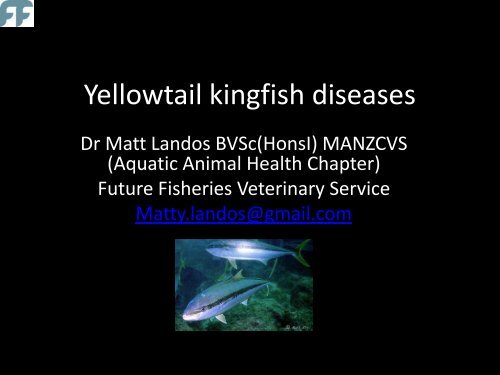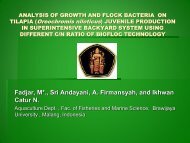Yellowtail kingfish diseases
Landos - Aquaculture
Landos - Aquaculture
- No tags were found...
Create successful ePaper yourself
Turn your PDF publications into a flip-book with our unique Google optimized e-Paper software.
<strong>Yellowtail</strong> <strong>kingfish</strong> <strong>diseases</strong>Dr Matt Landos BVSc(HonsI) MANZCVS(Aquatic Animal Health Chapter)Future Fisheries Veterinary ServiceMatty.landos@gmail.com
Health Management• Identify infectious <strong>diseases</strong>– Outbreak investigation (Field + Lab)• Implement monitoring• Undertake clinical trials/novel treatments• Define non-infectious disease syndromes• Implement improved husbandry• Collaborate with feed companies• Research areas of unknowns
Bacterial <strong>diseases</strong>• Photobacterium damselae ssp damselae– Reported in other fish to cause systemic disease– Identified from swabs from sick YTK duringmortality spikes– Identified as a component of the gut flora
IP vaccination location
Vaccine CRC study-PSFC NSW DII• No significant impact on growth• No reduction in survival in 30 days postvaccination• No evidence of serious tissue reactionaffecting product quality at injection site• Commercial trial results indicated improvedsurvival in vaccinated pen
Vaccination location-IP
Parasitic disease- gill fluke• Zeuxapta seriolae• Gill damage• Anaemia• Requires bathing with hydrogen peroxide• Praziquantel bath also efficacious• Requires constant load monitoring to assistwith bath timing• Fallowing critical for control
Parasitic disease- skin fluke• Benedenia seriolae• Cause severe skin irritation• Growth reduction and mortality• Requires hydrogen peroxide bathing• Timing of baths critical to control• Fallowing critical for control
Juvenile skin flukes recruit onto eyes
Parasitic disease- blood fluke• Paradeontacylixspp.• Uncertain ofclinical impact• Eggs observedin freshpreparations ofgill• Fallowing criticalfor control
Weight loss- YTK enteritis syndrome
YTK normal intestine
Thickened intestinal wall- full length
Reddened gut lining- thick wallchronic disease
Lymphocytic enteritis
Gut protozoa
Complex enteritis- players• Coccidia-like parasites• Myxidia-like parasites• Cryptosporidia-like parasites• Bacterial adhesion• Soyabean meal• Other potential diet factors
Proliferative lymphocytic enteritis
Sloughing enterocytes and protozoa
Similarities to European enteromyxum• Experimental treatment with coccidiostats– Amprolium + salinomycin• More research required to document– Species of protozoa– Efficacy of treatments– Environmental impacts– Precursors to infections
Proliferative enteritis- occluding gutlumen
Renal myxosporea
Parasitic copepods
Epitheliocystis
Parasitic disease- Others• Liver microsporidia• Muscle myxosporea (eg Kudoa sp.)• Migrating cestodes
Nutritional disease- SBM enteritis• CRC-SARDI research identified that highsubstitution rates resulted in reducedthickness of gut mucous• Potentially causing:– Increased risk of bacterial adhesions to gut lining– Increased permeability of gut wall– Increased presentation of enteric antigen to fishimmune system– Dysfunctional liver lipid metabolism
Canola oil substitution- SARDI CRC• Led to change in liver coloration• Reduced growth• May not provide sufficient long chain fattyacids
Nutritional disease- SBM enteritis• Some species of fish appear to be sensitive toSoya Bean Meal in their diet– Saponins and antinutritional factors implicated• Processing can remove some of these antinutritionalfactors, creating different soyaproducts such as Soya Protein Concentrate (SPC)• YTK may not have a high tolerance for SBMsubstitution in diets• Effects of substitution can be slow to be observed
Nutritional unknown- FM FOsubstitution• Fish have net requirement for long chain fattyacids that are only found in the fish meal andfish oil components of diets• Substitution in diets can result in a relativedeficiency• Deficiency can result in poor immunity,general increase in disease, poor gut mucosalimmunity
• Sensitive fish to grow• Many challenges indisease control• Many unknownsrequiring research• Species growthpotential and marketopportunities remainattractiveConclusions





